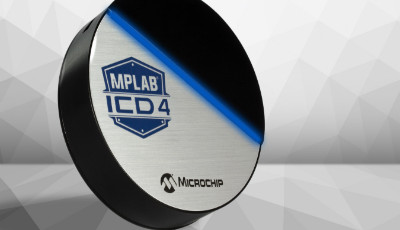Microchip's MPLAB gets new in-circuit debugger ICD 4
August 14, 2017
on
on

To load new firmware into a microcontroller and then debug it usually a special tool is required: the in-circuit programmer/debugger. Microchip’s PIC microcontrollers are no exception to this, and till today the preferred tool for programing and debugging PIC micros was the MPLAB ICD 3, the puck-shaped device that supported the full range of PIC and dsPIC devices. Now, after many years of loyal services the MPLAB ICD 3 is finally being replaced by the MPLAB ICD 4.
Like its predecessor the new MPLAB In-Circuit Debugger (ICD) 4 is round and housed in a durable, black case with a brushed aluminum top. Status is indicated with a colorful LED strip (the blue bar in the photo) instead of the three LEDs on the ICD 3. The ICD 4 includes all the features of the ICD 3, but is about two times faster. This speed increase is due to a 32-bit MCU running at 300 MHz and an increased buffer memory of 2 MB.
Other new features are a wider voltage range of 1.20 to 5.5 V and the possibility to connect an external power supply to power the target board through the ICD 4. It provides selectable pull-up/pull-down resistors on the debug connector (pins are connected through relays), the interface speed is configurable; it has improved fault detection and immunity and also works with JTAG interfaces.
One question remains: will the ICD 4 also support AVR and ARM devices in the future?
Photo: Microchip
Like its predecessor the new MPLAB In-Circuit Debugger (ICD) 4 is round and housed in a durable, black case with a brushed aluminum top. Status is indicated with a colorful LED strip (the blue bar in the photo) instead of the three LEDs on the ICD 3. The ICD 4 includes all the features of the ICD 3, but is about two times faster. This speed increase is due to a 32-bit MCU running at 300 MHz and an increased buffer memory of 2 MB.
Other new features are a wider voltage range of 1.20 to 5.5 V and the possibility to connect an external power supply to power the target board through the ICD 4. It provides selectable pull-up/pull-down resistors on the debug connector (pins are connected through relays), the interface speed is configurable; it has improved fault detection and immunity and also works with JTAG interfaces.
One question remains: will the ICD 4 also support AVR and ARM devices in the future?
Photo: Microchip
Read full article
Hide full article


Discussion (1 comment)